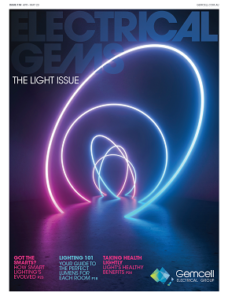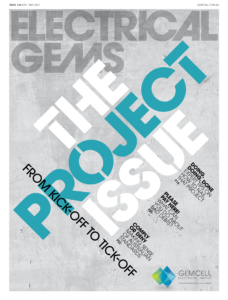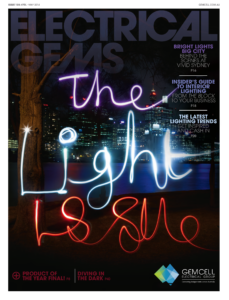Out Now
The Mental Health Issue
Current Issue
The Mental Health Issue
AUG - SEPT 2025

The light our kids are exposed to when they’re young can have a huge impact in the long term. Here’s everything you need to know.
The effect of lighting on the physical and emotional health of children is profound, especially in their critical developmental years.
Children’s eyes are not fully developed until their teenage years, and their pupils are larger than that of an adult. As a result, they absorb more light and are at a higher risk of circadian rhythm disruption. Anyone who’s had to put an energetic child to bed has experienced this first-hand!
Children spend most of their day in a classroom or childcare facility. For young children, kindergarten is where they learn to explore the world outside of their home, a place where they seek comfort and security.
Lighting, therefore, plays an important role in these spaces and optimised lighting should be an important consideration for their health and wellbeing.
Studies show that adequate illumination (typical of daylight), not only prevents the risk of developing nearsightedness but also helps prevent other health problems and disorders relating to circadian rhythm disruption.
Good lighting is also beneficial for brain development and may foster the formation of new brain pathways, which can ultimately enhance learning.
This kind of dynamic lighting positively impacts their mood, emotions, and health, while brightly lit classrooms have proven to improve behaviour and reduce stress and anxiety in children of all ages.
Correct lighting, in terms of colour temperature, intensity and dynamism in classrooms, has been shown in studies to increase reading speed by 35 per cent, while reducing comprehension errors by 45 per cent.
The right lighting – indirect illumination, the use of daylight, and friendly, warm white light colours – is important as it helps create a natural light environment where children, particularly those in kindergarten and new to schooling, feel safe and comfortable.
Clearly, lighting is a vital element in a child’s educational experience, whether they are in day care centres or in schools.
Today, modern lighting technology allows us the opportunity to use both variable lighting systems (where the intensity and colour temperature can be changed), and dynamic lighting (where adequate natural light is complemented by artificial illumination) in school and childcare settings. Both of these options can adapt lighting solutions to benefit the circadian and emotional rhythms of children and improve their outcomes at school.
Keep up to date with our latest news and competitions by subscribing to our regular newsletter.

Issue 183
OCT - NOV 2024

Issue 182
AUG - SEPT 2024

Issue 181
JUN - JUL 2024

Issue 180
APR - MAY 2024

Issue 179
FEB - MARCH 2024

Issue 178
DEC 2023 - JAN 2024

Issue 177
OCT - NOV 2023

Issue 176
AUG - SEPT 2023

Issue 175
JUN - JUL 2023

Issue 174
APR - MAY 2023

Issue 173
FEB - MAR 2023

Issue 172
DEC 2022 - JAN 2023

Issue 171
OCT - NOV 2022

Issue 170
AUG - SEPT 2022

Issue 169
JUN - JUL 2022

Issue 168
APR - MAY 2022

Issue 167
FEB - MAR 2022

Issue 166
DEC 2021 - JAN 2022

Issue 165
OCT - NOV 2021

Issue 164
AUG - SEPT 2021

Issue 163
JUN - JUL 2021

Issue 162
APR - MAY 2021

Issue 161
FEB - MAR 2021

Issue 160
DEC 2020 - JAN 2021

Issue 159
OCT - NOV 2020

Issue 158
AUG - SEPT 2020

Issue 157
JUN - JUL 2022

Issue 156
APR - MAY 2020

Issue 155
FEB - MAR 2020

Issue 154
DEC 2019 - JAN 2020

Issue 153
OCT - NOV 2019

Issue 152
AUG - SEPT 2019

Issue 151
JUN - JUL 2019

Issue 150
APR - MAY 2019

Issue 149
FEB - MAR 2019

Issue 148
DEC 2018 - JAN 2019

Issue 147
OCT - NOV 2018

Issue 146
AUG - SEPT 2018

Issue 145
JUN - JUL 2018

Issue 144
APR - MAY 2018

Issue 143
FEB - MAR 2018

Issue 142
DEC 2016 - JAN 2017

Issue 141
OCT- NOV 2017

Issue 140
AUG - SEPT 2017

Issue 139
JUN - JUL 2017

Issue 138
APR - MAY 2017

Issue 137
FEB - MAR 2017

Issue 136
DEC 2016 - JAN 2017

Issue 135
OCT - NOV 2017

Issue 134
AUG - SEPT 2016

Issue 133
JUN - JUL 2016

Issue 132
APR - MAY 2016

Issue 131
FEB - MAR 2016

Issue 130
DEC 2015 - JAN 2016

Issue 129
OCT - NOV 2015

Issue 128
AUG - SEPT 2015

Issue 127
JUN - JUL 2015

Issue 125
APR - MAY 2015

Issue 125
FEB - MAR 2015

Issue 124
DEC 2014 - JAN 2015

Issue 123
OCT - NOV 2014

Issue 122
AUG - SEPT 2014

Issue 121
JUN - JUL 2014

Issue 120
APR - MAY 2014

Issue 119
FEB - MAR 2014

Issue 118
DEC 2013 - JAN 2014

Issue 117
OCT - NOV 2013

Issue 116
AUG - SEPT 2013

Comments (0)
Write a Comment